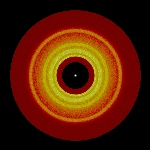 |
Terrestrial planets are rocky planets
Mercury, Venus, Earth, and Mars are mostly rock
Asteroids are rocky fragments of protoplanets
Terrestrial planets grow by accreting smaller objects
Disk-shaped nebula of dust and gas
Dust grains collide and merge
Large (1 mm) dust grains fall into a thin, dusty sheet
Collisions produce planetesimals 1 m to 1 km across
More collisions produce planets
Planets stir up the leftover planetesimals
Planetesimal then collide and fragment
A cascade of collisions reduces fragments to dust
Planets sweep up some of the dust
Radiation and a wind from the central star remove the rest
Computer calculations produce Earths in 1-10 Myr
Results for a small simulation without fragmentation
Results for a large simulation without fragmentation
Computer calculations produce lots of dust in 1-10 Myr
Results for a small simulation with fragmentation
Results for a large simulation without fragmentation
Observations can test these models
Dust from the collisional cascade is observable
Dust geometry and luminosity can test the model
| |

Debris disks are the dusty remains of planet formation.
Learn more ...
| |





